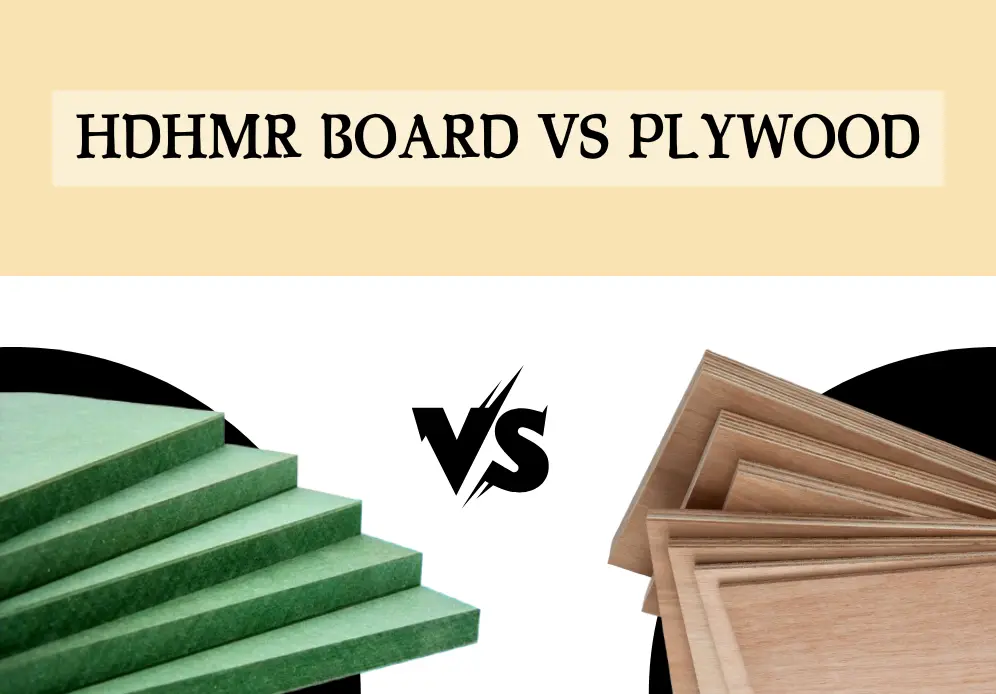When it comes to selecting the right material for furniture and cabinetry, two popular competitive options are HDHMR vs plywood. Both HDHMR and plywood prices are different in India but both have unique properties that make them suitable for different applications.
This article provides an in-depth comparison and difference between HDHMR and plywood, focusing on their composition, advantages, disadvantages, and applications.
What Is the HDHMR Sheets?
HDHMR stands for High-Density High Moisture Resistant Sheets. It is an engineered wood product made by compressing hardwood fibres with a special adhesive under high pressure. This process results in a dense, durable, and moisture-resistant board that is ideal for various applications.
What Is Plywood?
Plywood is another popular engineered wood product. It is made by bonding thin layers of wood veneers together. Each layer, or ply, is glued with its grain at right angles to adjacent layers, providing strength and stability.
Key Difference Between HDHMR And Plywood
Choosing between HDHMR and plywood requires understanding their key differences. Here’s a detailed comparison:
1. Composition And Structure
- HDHMR Board: It is composed of hardwood fibres compressed with adhesive, resulting in a homogeneous structure.
- Plywood: It is made up of multiple layers of wood veneers glued together, creating a cross-grain structure for added strength.
2. Moisture Resistance
- HDHMR Board: It offers superior moisture resistance, making it suitable for humid environments.
- Plywood: While there are moisture-resistant grades, standard plywood is more prone to water damage compared to HDHMR.
3. Strength And Durability
- HDHMR Board: Known for their exceptional density and strength, HDHMR boards offer superior durability and resistance to wear and tear. Their high moisture resistance ensures they maintain structural integrity even in humid conditions, making them ideal for long-term use in demanding environments.
- Plywood: It provides excellent strength due to its layered construction which provides excellent strength and stability. But it can delaminate under extreme conditions especially if not treated properly.
4. Cost
- HDHMR Board: Generally, HDHMR boards are more expensive than standard plywood due to their advanced manufacturing process and enhanced properties, such as higher density and moisture resistance.
- Plywood: Plywood, on the other hand, offers a more budget-friendly option with adequate performance for many applications, making it a versatile and economical choice for various projects.
Applications Of HDHMR Sheets vs Plywood
Understanding the specific applications of HDHMR and plywood is important to make an informed decision for your projects. Each material has its strengths and is better suited for particular uses. Here’s a detailed look at how HDHMR and plywood perform in various applications:
1. Furniture
- HDHMR: It is ideal for high-use furniture due to its durability and moisture resistance.
- Plywood: It is suitable for both indoor and outdoor furniture; marine plywood is preferred for high-moisture areas.
2. Cabinetry
- HDHMR: It is perfect for kitchen and bathroom cabinets where moisture resistance is crucial.
- Plywood: It’s commonly used for cabinets but may need additional treatment in moisture-prone areas.
3. Interior Decoration
- HDHMR: It provides a high-quality finish for decorative panels and partitions.
- Plywood: Versatile for various interior solutions like applications, including wall panelling and false ceilings.
4. Installation And Workability
- HDHMR Sheet: HDHMR board is heavier and denser, requiring specialized tools for cutting and shaping.
- Plywood: Plywood is easier to cut and shape with standard woodworking tools.
5. Environmental Impact
- HDHMR: It uses hardwood fibres and synthetic adhesives; sourcing from certified suppliers can ensure sustainability.
- Plywood: It is made up of natural wood veneers, opting for sustainably sourced plywood reduces environmental impact.
When competing HDHMR vs plywood price, it’s essential to consider the specific requirements of your project. HDHMR’s higher cost is often balanced by its superior performance in demanding environments. Plywood offers a more economical option with adequate performance for many applications.
Conclusion
The choice between HDHMR vs plywood depends on your specific needs and budget. For high-moisture and high-use areas, the HDHMR board is a superior choice. For general applications, plywood offers versatility and cost-effectiveness. MRS Woodcraft is here to provide you with the best materials to meet your project requirements
Frequently Asked Questions?
What Is The Main Difference Between HDHMR And Plywood?
The main difference lies in their composition and moisture resistance. HDHMR board is made from compressed hardwood fibres and offers superior moisture resistance, while plywood is made from wood veneers and is more versatile but less moisture-resistant.
Is HDHMR Board More Expensive Than Plywood?
Yes, HDHMR generally has a higher price point due to its enhanced properties, but the cost is often justified by its durability and performance.
HDHMR VS Plywood Which Is Better?
The choice between HDHMR board vs plywood depends on your requirements. HDHMR offers high moisture resistance and durability at a higher cost while plywood is more budget-friendly and offers a wide variety of options.
How Does The HDHMR Board Compare To HDF?
HDHMR offers better moisture resistance and durability compared to HDF, making it suitable for more demanding environments.
Which Is More Durable, Plywood Or HDHMR Board?
HDHMR offers higher durability and resistance to moisture compared to plywood, making it suitable for high-humidity environments and heavy-use areas.

